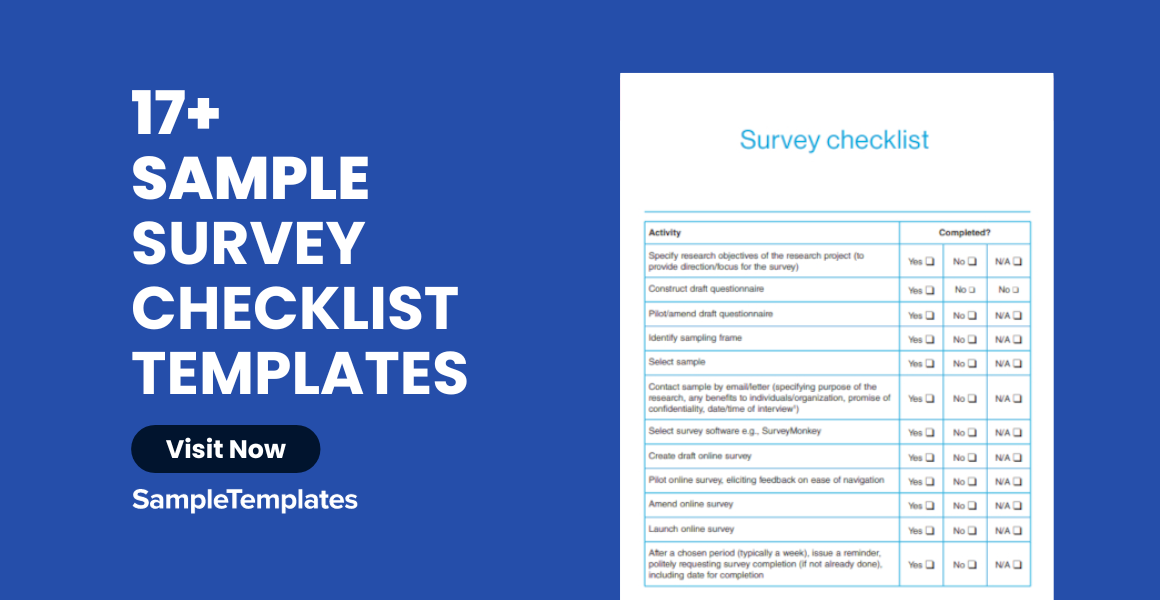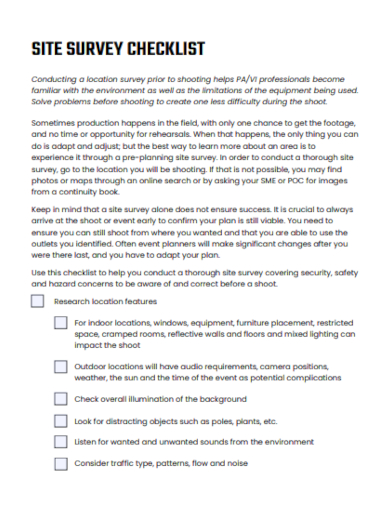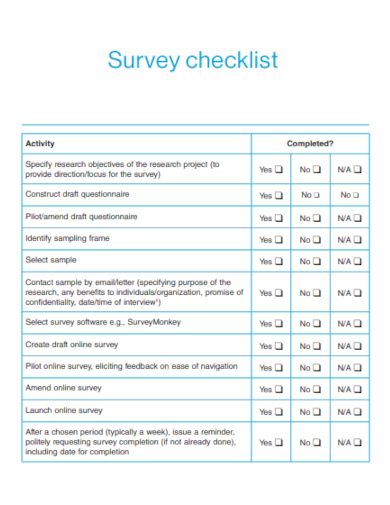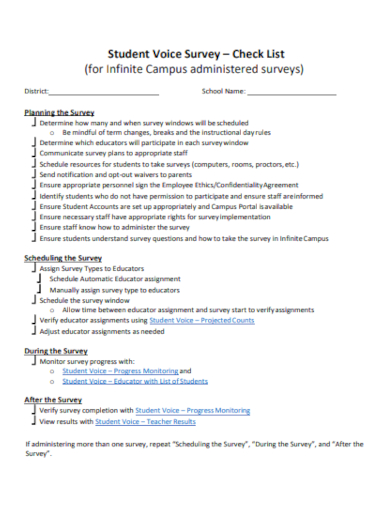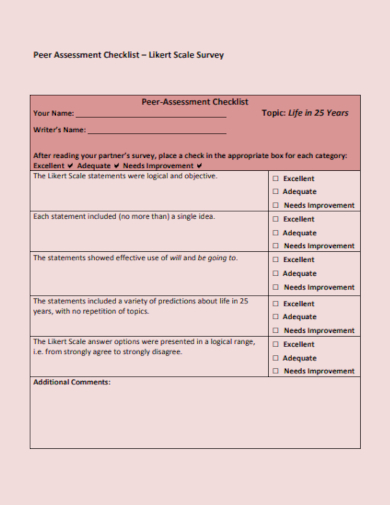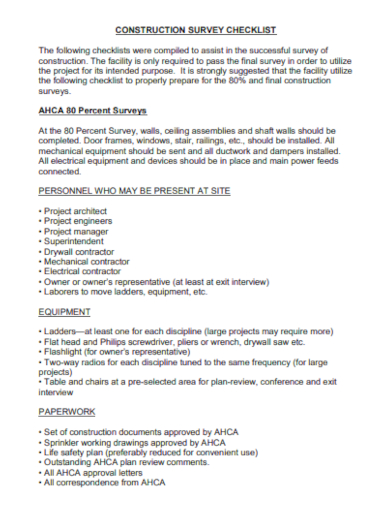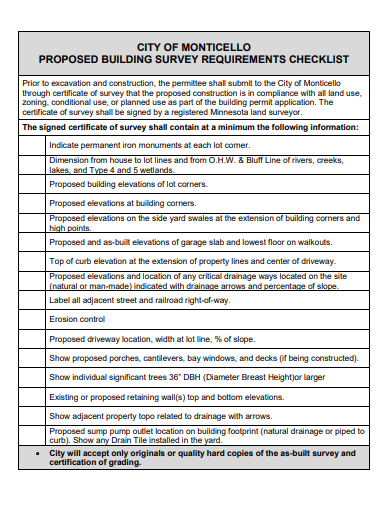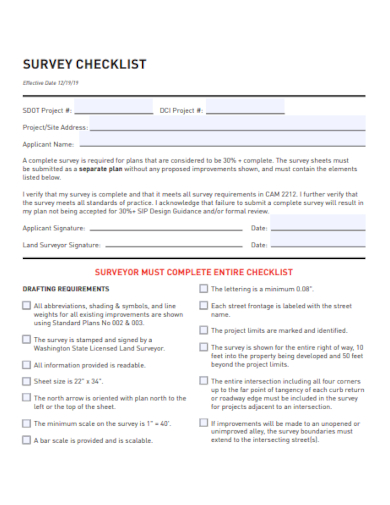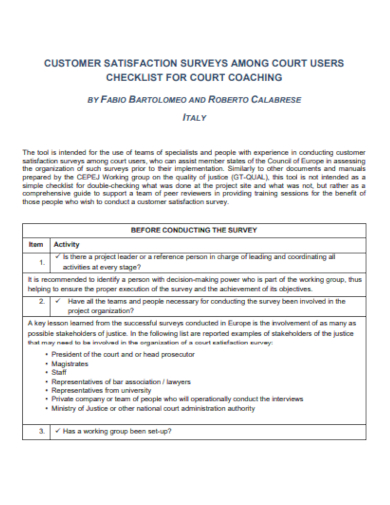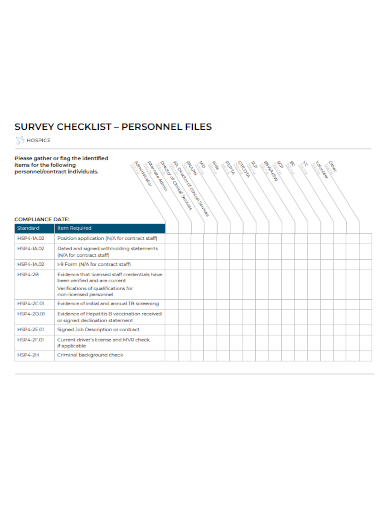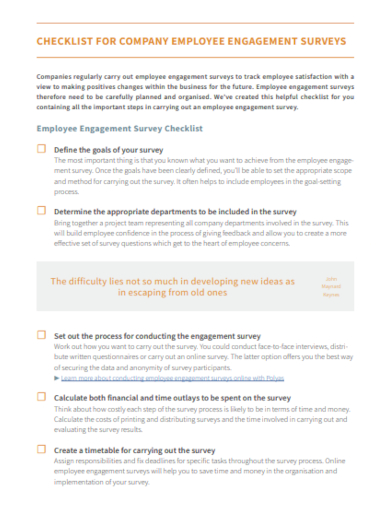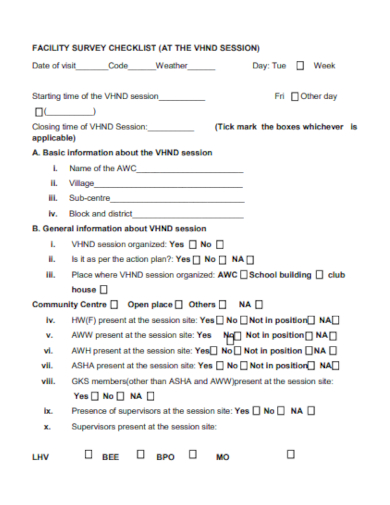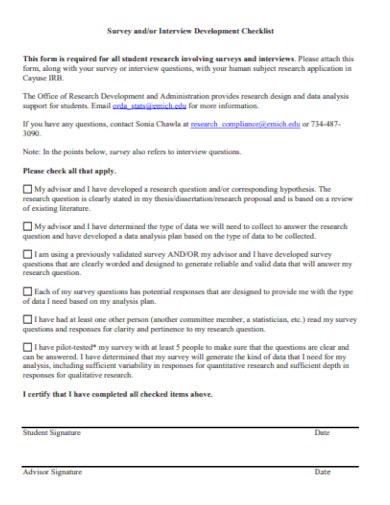In today’s data-driven world, conducting accurate surveys is crucial for obtaining valuable insights. The ‘Survey Checklist’ is your go-to guide, ensuring every vital aspect is covered. Whether you’re a novice researcher or a seasoned analyst, this sample checklist ensures clarity, precision, and effectiveness in your data collection efforts. Leveraging these tips, you’ll not only streamline your process but also ensure that your findings are reliable and actionable. Dive in to optimize your survey strategies.
17+ Survey Checklist Samples
1. Sample Construction Project Site Survey Checklist
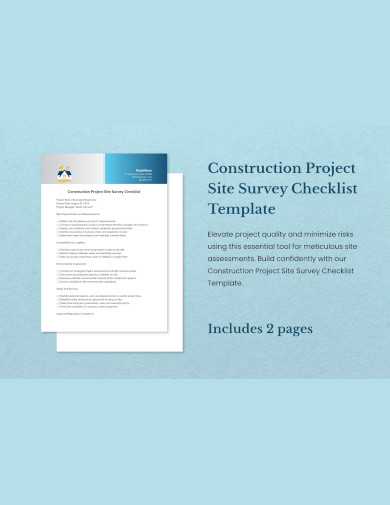
2. Sample Checklist Template
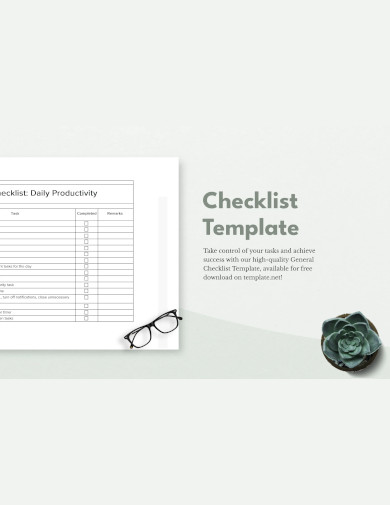
3. Basic Checklist Template
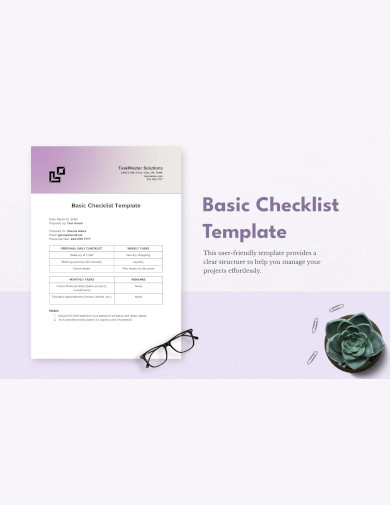
4. Formal Checklist Template
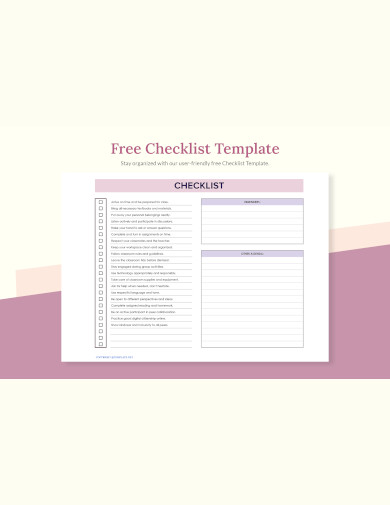
5. Printable Checklist Template
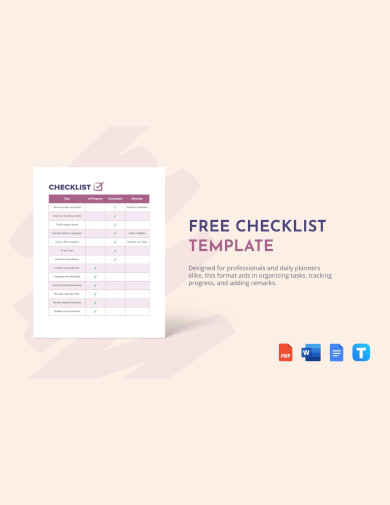
What is a Survey Checklist?
Understanding the Basics
At its core, a survey checklist is a tool used to ensure that all necessary steps and components of a survey are accounted for and executed properly. Whether you’re designing a market research study, employee feedback form, or a public opinion poll, a survey checklist ensures that every phase of the survey process is methodically addressed.
The Importance of a Survey Checklist
While surveys might seem straightforward at a glance, they involve meticulous planning and execution to ensure accurate and actionable results. Here’s why a checklist is indispensable:
- Quality Assurance: The last thing any surveyor wants is to find out after collecting responses that a crucial question was overlooked, or that data was mishandled. A checklist acts as a safeguard against these oversights.
- Consistency: Especially in larger projects with multiple stakeholders, consistency is key. A printable checklist ensures every person involved knows the standard procedures and follows them.
- Efficiency: By having a clear list of steps to follow, the process becomes streamlined, making it easier to manage and reducing the chances of unnecessary delays or redoing tasks.
Key Components of a Survey Checklist
While every sample survey will have unique requirements, some fundamental components are usually included in most checklists:
- Objective Definition: Before even crafting questions, it’s crucial to define what you want to achieve with the survey. This phase includes setting clear goals and identifying the target audience.
- Question Design: This involves creating unbiased and clear questions, ensuring they align with the survey’s sample objectives, and deciding on the type of questions (multiple choice, open-ended, etc.).
- Survey Distribution: Planning how and when to distribute the survey is vital. This could involve email, web links, or even printed copies.
- Data Collection & Analysis: Once responses start pouring in, the data needs to be collected systematically. After collection, it’s analyzed to draw meaningful insights.
- Feedback & Iteration: After the survey is complete, it’s beneficial to evaluate the process, gather sample feedback, and make improvements for future surveys.
Incorporating Technology
In today’s digital age, there are numerous platforms and tools available that not only help in designing surveys but also incorporate built-in checklists to guide users. Leveraging these tools can save time, reduce errors, and enhance the survey’s overall efficiency.
Benefits of Using a Survey Checklist
- Comprehensive Data Collection: Ensures that all essential data points are captured.
- Improved Response Rate: A well-structured survey is more likely to be completed by respondents.
- Data Consistency: Provides a structured format that makes data analysis more straightforward.
- Time Efficiency: Saves time during the creation and sample review stages of survey development.
Common Pitfalls and How to Avoid Them
- Ambiguity: Avoid vague questions; be as specific as possible.
- Double-Barreled Questions: Don’t ask two things in one question.
- Overloading: Too many questions can deter respondents. Prioritize and keep it concise.
- Bias: Ensure neutrality in questions to get honest responses.
Implementing the Survey Checklist
- Choosing the Right Platform: Pros and cons of various survey tools and platforms.
- Pilot Testing: The importance of testing your survey before full implementation.
Analyzing Results from the Survey Checklist
- Quantitative vs. Qualitative Analysis: Understanding the type of data you’ve collected and how to interpret it.
- Common Pitfalls and Mistakes: How to avoid errors in sample analysis and interpretation.
6. Sample Site Survey Checklist Template
7. Sample Research Survey Checklist Template
8. Sample Student Survey Checklist Template
9. Sample Peer Assessment Survey Checklist Template
10. Sample Construction Survey Checklist Template
11. Sample Proposed Building Survey Checklist Template
12. Sample Lab Safety Survey Checklist Template
13. Sample Survey Checklist Form Template
14. Sample Customer Satisfaction Survey Checklist Template
15. Sample Document Survey Checklist Template
16. Sample Company Employee Survey Checklist Template
17. Sample Hospital Facility Survey Checklist Template
18. Sample Survey Interview Checklist Template
How do you Create a Survey Checklist?
Creating a survey can be a daunting task, but having a checklist can streamline the process and ensure that every aspect is covered. Whether you’re gauging customer satisfaction, conducting market research, or gathering feedback on a new product, a well-designed survey is crucial for collecting accurate and actionable insights. Here’s a five-step checklist to help you craft an effective survey:
- Define Your Objectives
Understand the Purpose: Every survey should have a clear goal. Are you trying to measure the satisfaction of your customers? Do you want to understand the needs of your target market better? Clearly defining your objectives will guide your questions and ensure you gather the data you need. Example: If you are launching a new product and want to know the features customers value most, your objective might be: “Determine the top three features potential customers want in [product category].” - Design Your Questions
Quality Over Quantity: It’s better to have fewer, high-quality questions than a slew of irrelevant ones. Ensure that each question aligns with your objective and is clear and concise. Types of Questions: Use a mix of open-ended questions, multiple choice, and scales. This variety can provide both quantitative and qualitative feedback. Example: For a product feedback survey, you might ask: “On a scale of 1-10, how satisfied are you with [product feature]?” followed by “What improvements would you suggest?” - Choose Your Audience
Segmentation: Not every survey is meant for everyone. Segment your audience based on demographics, buying behavior, or other relevant criteria to ensure you’re getting feedback from the right people. Size Matters: Depending on your objectives, decide on the sample size. A larger sample size can provide more accurate results but may also require more resources to analyze. Example: If you are surveying for a new women’s fitness product, you might target women aged 20-40 who have shown interest in fitness and health. - Test Your Survey
Pilot Testing: Before rolling out your survey to a larger audience, test it with a small group. This can help identify any confusing questions or technical glitches. Feedback on the Feedback: Ask your pilot group about the overall experience. Were the questions clear? Was the simple survey too long? Example: If testers consistently skip a particular question, it might be too complex or not relevant. Consider revising or removing it. - Analyze and Implement
Gather Data: Once your survey is complete, compile the responses. Use tools or software that can help you sort and analyze the data effectively. Draw Insights: Look for patterns and trends in the answers. This will provide actionable insights that align with your objectives. Take Action: The goal of every survey should be to gather insights that can inform decisions. Implement changes based on feedback, and consider communicating back to respondents to let them know their input was valuable. Example: If 80% of respondents indicate a desire for a particular product feature, prioritize its development in your next product iteration.
In Conclusion, In the vast landscape of data gathering, surveys remain one of the most effective tools for capturing targeted information. A survey checklist is the unsung hero behind successful surveys, ensuring that every detail is in place and every process runs smoothly. Whether you’re a seasoned researcher or just starting, incorporating a survey checklist can significantly elevate the quality and efficiency of your surveys. You can also see more templates like Questionnaire Checklist Samples.
Related Posts
FREE 18+ Internship Checklist Samples in MS Word | Google Docs | PDF
FREE 18+ Statement Checklist Samples in MS Word | Google Sheets | PDF
FREE 20+ Voluntary Checklist Samples in MS Word | Google Sheets | PDF
FREE 18+ Summary Checklist Samples in MS Word | Google Sheets | PDF
FREE 14+ Sponsorship Checklist Samples in MS Word | MS Excel | PDF
FREE 18+ Conference Checklist Samples in MS Word | Google Sheets | PDF
FREE 17+ Lesson Checklist Samples in MS Word | Google Sheets | PDF
FREE 18+ Progress Checklist Samples in MS Word | Google Docs | PDF
FREE 18+ Enrollment Checklist Samples in MS Word | Google Docs | PDF
FREE 18+ Graduation Checklist Samples in MS Word | Google Sheets | PDF
FREE 15+ Consent Checklist Samples in MS Word | Google Sheets | PDF
FREE 18+ Review Checklist Samples in MS Word | Apple Pages | PDF
FREE 18+ Submission Checklist Samples in MS Word | Google Docs | PDF
FREE 18+ Request Checklist Samples in MS Word | MS Excel | PDF
FREE 21+ Faculty Checklist Samples in MS Word | Google Sheets | PDF
